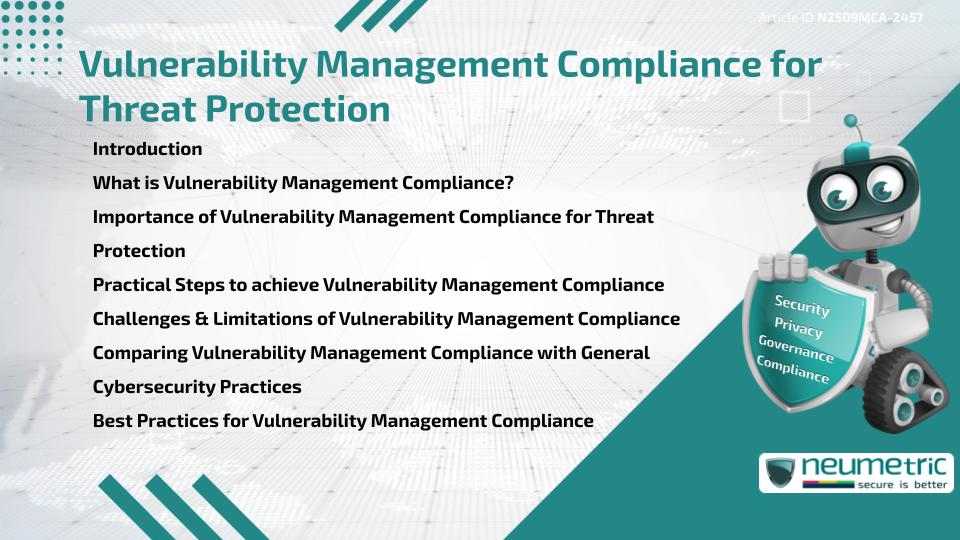Table of Contents
ToggleIntroduction
Vulnerability Management Compliance is the Structured process of identifying, evaluating & remediating Security Weaknesses while adhering to Regulatory Standards & Policies. It ensures that organisations reduce Risks from Cyber Threats, align with Industry regulations & build trust with Stakeholders. By combining Security Practices with Compliance obligations, Vulnerability Management Compliance becomes a cornerstone of effective Threat Protection.
What is Vulnerability Management Compliance?
Vulnerability Management Compliance involves Systematically Scanning Systems, prioritising Vulnerabilities & Applying fixes in accordance with Standards like PCI DSS or ISO 27001. Much like routine Medical Check-ups prevent Long-term health issues, this Compliance ensures organisations detect & resolve Risks before attackers Exploit them.
Importance of Vulnerability Management Compliance for Threat Protection
This Compliance is critical because it:
- Reduces Risk: Closes Exploitable Gaps in Networks & Applications.
- Ensures Regulatory Alignment: Meets obligations under Laws such as GDPR & HIPAA.
- Improves Efficiency: Streamlines Vulnerability handling with clear processes.
- Builds Confidence: Demonstrates proactive Security to Customers & Regulators.
Without Vulnerability Management Compliance, organisations face increased Attack Surfaces & Potential Penalties for Non-compliance.
Practical Steps to achieve Vulnerability Management Compliance
Organisations can establish Vulnerability Management Compliance by:
- Asset Inventory: Identify all Devices, Applications & Systems.
- Regular Scanning: Perform Automated Scans for Vulnerabilities.
- Risk Prioritisation: Address Critical Vulnerabilities first.
- Patch Management: Apply updates promptly to reduce Risks.
- Documentation: Record Findings & Remediation for Audit purposes.
More guidance can be found in NIST Vulnerability Management resources.
Challenges & Limitations of Vulnerability Management Compliance
Common challenges include:
- Resource Constraints: Smaller organisations may lack dedicated Staff or Tools.
- Complex Environments: Cloud, IoT & Hybrid setups increase difficulty.
- Evolving Threats: New Vulnerabilities appear faster than they can be patched.
- Human Error: Misconfigurations or Delays in patching can weaken Compliance.
These challenges highlight why Compliance must be continuous, not occasional.
Comparing Vulnerability Management Compliance with General CyberSecurity Practices
General CyberSecurity Practices cover a wide range of Risks, from Phishing to Malware. Vulnerability Management Compliance, however, Zeroes in on identifying & fixing weaknesses. It can be compared to home Maintenance: General Security is keeping the house safe overall, while Vulnerability Management Compliance is repairing cracks in the walls before they cause Major Damage.
For more on CyberSecurity Practices, see this CISA resource.
Best Practices for Vulnerability Management Compliance
Best Practices include:
- Automating Vulnerability Scanning & Reporting.
- Integrating Compliance Requirements into Patch Management processes.
- Training Staff to recognise & address Vulnerabilities quickly.
- Regularly reviewing Compliance status against Regulatory Frameworks.
- Establishing a Culture of Continuous Improvement in Security.
These practices ensure Compliance efforts directly contribute to stronger Threat Protection.
Conclusion
Vulnerability Management Compliance strengthens Threat Protection by ensuring Vulnerabilities are identified, prioritised & remediated in line with Regulations. By following practical steps, addressing challenges & applying Best Practices, organisations reduce Risks & Improve Resilience while maintaining Regulatory Trust.
Takeaways
- Vulnerability Management Compliance reduces Risks & Meets Regulatory Standards.
- Practical steps include Scanning, Prioritisation, Patching & Documentation.
- Challenges involve Limited Resources, Complex Systems & Evolving Threats.
- Best Practices embed Compliance into daily Operations for stronger Protection.
FAQ
What is Vulnerability Management Compliance?
It is the process of identifying & remediating Vulnerabilities while adhering to Regulations & Policies.
Why is Vulnerability Management Compliance important?
It reduces Risks, ensures Compliance & strengthens Stakeholder confidence.
How often should Vulnerability Scans be performed?
They should be conducted monthly or after major System changes.
What challenges exist in Vulnerability Management Compliance?
Challenges include Resource shortages, complex Environments & Emerging Threats.
How does Vulnerability Management Compliance differ from general CyberSecurity?
It focuses specifically on fixing Vulnerabilities, while CyberSecurity addresses broader Threats.
References
- PCI DSS – Security Standards
- ISO – ISO 27001 Information Security
- NIST – CyberSecurity Publications
- CISA – CyberSecurity Resources
- OWASP – Vulnerability Management Guidance
Need help for Security, Privacy, Governance & VAPT?
Neumetric provides organisations the necessary help to achieve their CyberSecurity, Compliance, Governance, Privacy, Certifications & Pentesting needs.
Organisations & Businesses, specifically those which provide SaaS & AI Solutions in the Fintech, BFSI & other regulated sectors, usually need a CyberSecurity Partner for meeting & maintaining the ongoing Security & Privacy needs & requirements of their Enterprise Clients & Privacy conscious Customers.
SOC 2, ISO 27001, ISO 42001, NIST, HIPAA, HECVAT, EU GDPR are some of the Frameworks that are served by Fusion – a SaaS, multimodular, multitenant, centralised, automated, CyberSecurity & Compliance Management System.
Neumetric also provides Expert Services for technical Security which covers VAPT for Web Applications, APIs, iOS & Android Mobile Apps, Security Testing for AWS & other Cloud Environments & Cloud Infrastructure & other similar scopes.
Reach out to us by Email or filling out the Contact Form…


